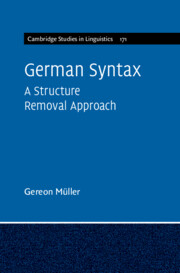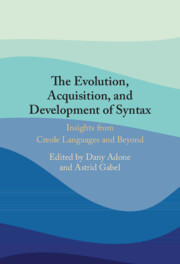Refine search
Actions for selected content:
6584 results in Grammar and Syntax
5 - Long-Distance Passive
-
- Book:
- German Syntax
- Published online:
- 28 February 2025
- Print publication:
- 06 March 2025, pp 218-249
-
- Chapter
- Export citation
1 - Structure Building
-
- Book:
- German Syntax
- Published online:
- 28 February 2025
- Print publication:
- 06 March 2025, pp 5-87
-
- Chapter
- Export citation
Contents
-
- Book:
- German Syntax
- Published online:
- 28 February 2025
- Print publication:
- 06 March 2025, pp ix-xii
-
- Chapter
- Export citation
3 - Passive
-
- Book:
- German Syntax
- Published online:
- 28 February 2025
- Print publication:
- 06 March 2025, pp 112-172
-
- Chapter
- Export citation
References
-
- Book:
- German Syntax
- Published online:
- 28 February 2025
- Print publication:
- 06 March 2025, pp 332-376
-
- Chapter
- Export citation
Dedication
-
- Book:
- German Syntax
- Published online:
- 28 February 2025
- Print publication:
- 06 March 2025, pp vii-viii
-
- Chapter
- Export citation
Frontmatter
-
- Book:
- German Syntax
- Published online:
- 28 February 2025
- Print publication:
- 06 March 2025, pp i-vi
-
- Chapter
- Export citation
2 - Structure Removal
-
- Book:
- German Syntax
- Published online:
- 28 February 2025
- Print publication:
- 06 March 2025, pp 88-111
-
- Chapter
- Export citation

German Syntax
- A Structure Removal Approach
-
- Published online:
- 28 February 2025
- Print publication:
- 06 March 2025

The Evolution, Acquisition and Development of Syntax
- Insights from Creole Languages and Beyond
-
- Published online:
- 19 February 2025
- Print publication:
- 06 February 2025
15 - Construction Grammar and Gesture
- from Part IV - Multimodality and Construction Grammar
-
-
- Book:
- The Cambridge Handbook of Construction Grammar
- Published online:
- 30 January 2025
- Print publication:
- 06 February 2025, pp 384-404
-
- Chapter
- Export citation
8 - Missing Subjects in Creole Acquisition: Insights from Jamaican and Morisyen
- from Part II - The Acquisition of Syntax
-
-
- Book:
- The Evolution, Acquisition and Development of Syntax
- Published online:
- 19 February 2025
- Print publication:
- 06 February 2025, pp 137-153
-
- Chapter
- Export citation
9 - Home Signs as a Window on Language Creation
- from Part II - The Acquisition of Syntax
-
-
- Book:
- The Evolution, Acquisition and Development of Syntax
- Published online:
- 19 February 2025
- Print publication:
- 06 February 2025, pp 154-169
-
- Chapter
- Export citation
11 - A Matter of Degree: All Languages are Mixed
- from Part III - The Development of Syntax
-
-
- Book:
- The Evolution, Acquisition and Development of Syntax
- Published online:
- 19 February 2025
- Print publication:
- 06 February 2025, pp 193-208
-
- Chapter
- Export citation
Figures
-
- Book:
- The Cambridge Handbook of Construction Grammar
- Published online:
- 30 January 2025
- Print publication:
- 06 February 2025, pp ix-xii
-
- Chapter
- Export citation
Part III - Case Studies in Constructional Morphosyntax
-
- Book:
- The Cambridge Handbook of Construction Grammar
- Published online:
- 30 January 2025
- Print publication:
- 06 February 2025, pp 247-334
-
- Chapter
- Export citation
Contributors
-
- Book:
- The Evolution, Acquisition and Development of Syntax
- Published online:
- 19 February 2025
- Print publication:
- 06 February 2025, pp ix-ix
-
- Chapter
- Export citation
Abbreviations
-
- Book:
- The Evolution, Acquisition and Development of Syntax
- Published online:
- 19 February 2025
- Print publication:
- 06 February 2025, pp xi-xii
-
- Chapter
- Export citation
7 - Acquisition of Negation in Jamaican
- from Part II - The Acquisition of Syntax
-
-
- Book:
- The Evolution, Acquisition and Development of Syntax
- Published online:
- 19 February 2025
- Print publication:
- 06 February 2025, pp 119-136
-
- Chapter
- Export citation
19 - Constructions and Lectal Variation
- from Part V - Constructions in Sociocultural and Typological Variation
-
-
- Book:
- The Cambridge Handbook of Construction Grammar
- Published online:
- 30 January 2025
- Print publication:
- 06 February 2025, pp 497-518
-
- Chapter
- Export citation
